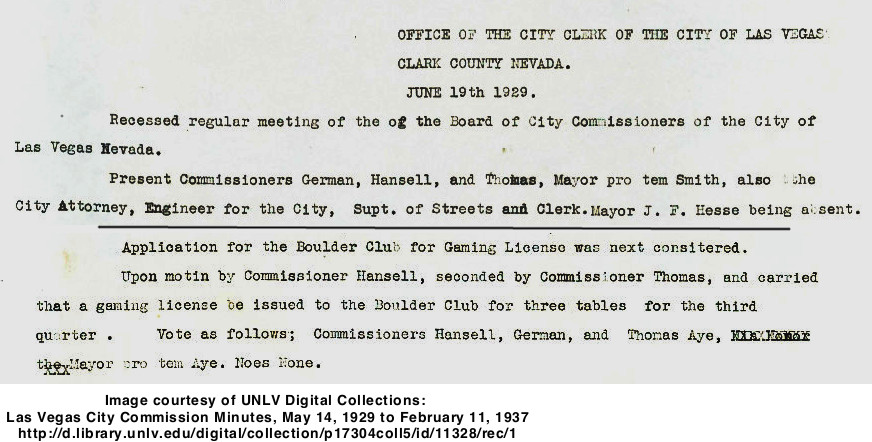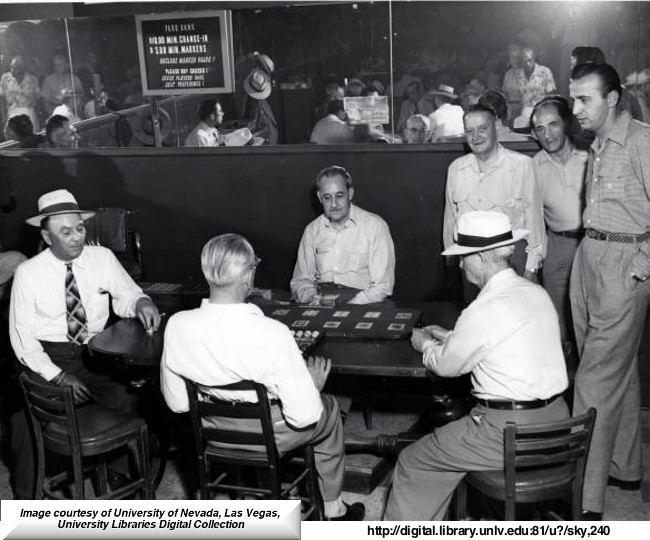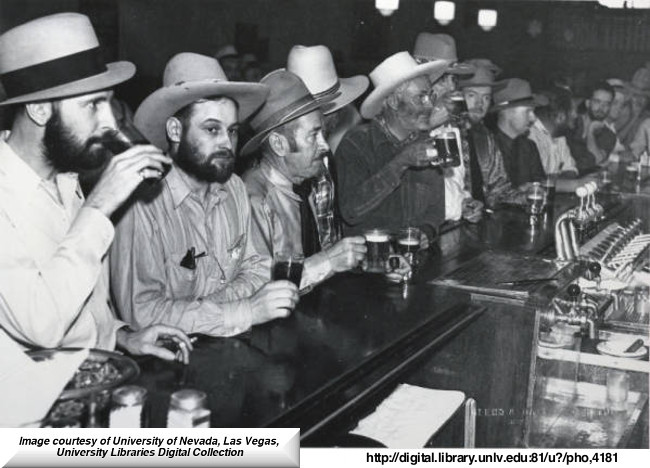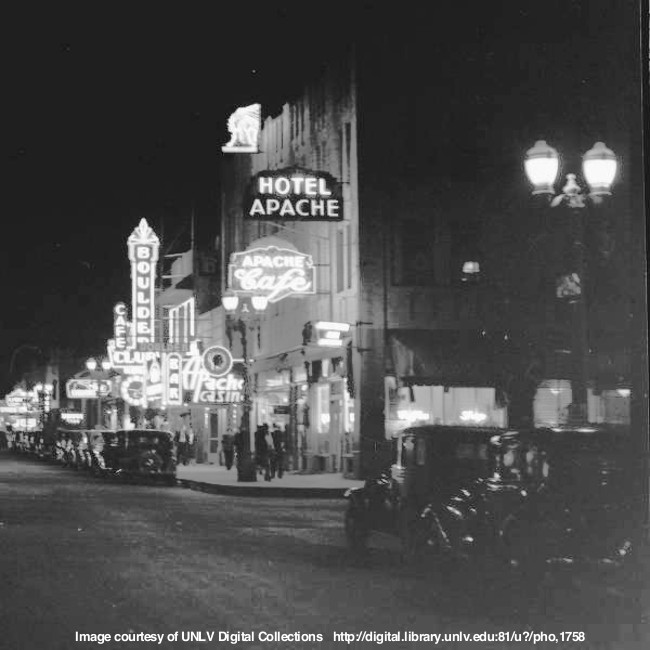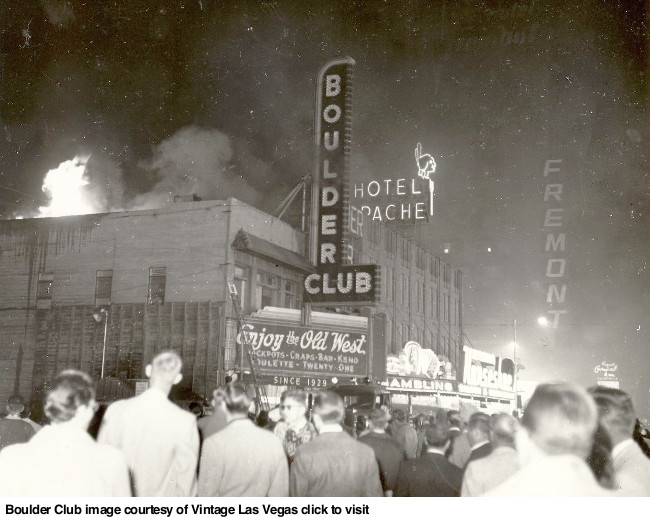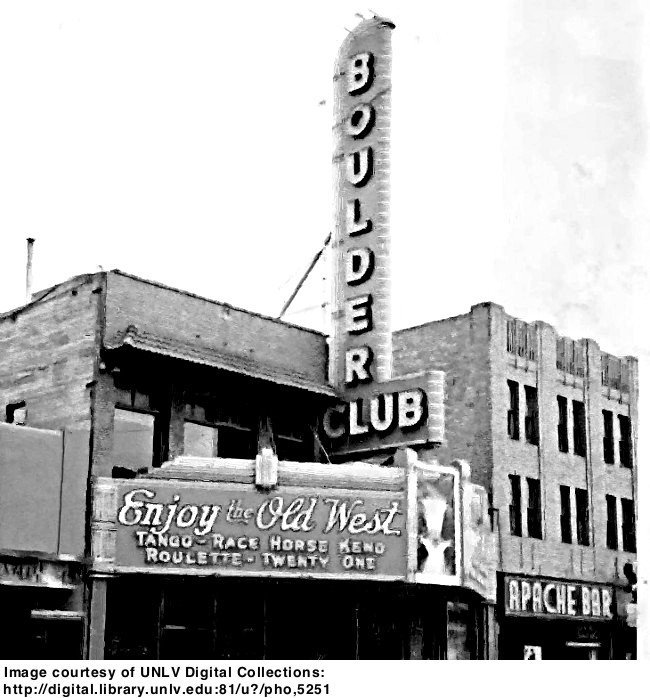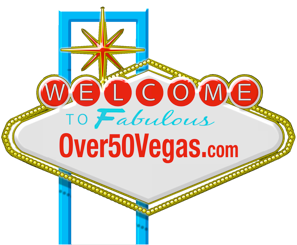- About Over50Vegas
- How did Las Vegas become Las Vegas?
- Observations by Charles "Pop" Squires- Las Vegas Pioneer and Publisher
- Books and References Sites
- Las Vegas Phonebook and City Directories of Bars, Casinos and Hospitality Properties
- Casino Collectible Shows & Local Meetings
- Visit the ChipGuide
- Visit the Museum of Gaming History
- Visit the Casino Chip & Gaming Token Collectors Club, Inc.
- Sitemap by name of property
- Sitemap by address of property
- Click here to request page update notifications
- Contact Over50Vegas
118 Fremont
Las Vegas, NV
Boulder Club
19
29
to 1960
Photograph of a faro card game in the Boulder Club (Las Vegas), 1953
Description:Faro table in the Boulder Club Card Room.
Transcribed from photo:
"The card room at the back of the old Boulder Club where Larry Hazelwood played bridge, Jimmy Young played poker, etc. Permission to take this photo given by Jimmy Young, part owner along with Ken Houssels, Sr., Larry Hazelwood, Connie Hurley, and Mrs. Witcher. At the table left a shill from Horseshoe; right- Blackie- a Boulder Club shill; Standing behind Blackie, Boulder Club Bar manager, Ben; Standing next to Ben two regulars of the Boulder Club."
Transcribed from photo sleeve: "About August, 1953"
(From UNLV Special Collections. Click on the photo to be taken to their site.)
A few weeks after the articicle above appeared limiting gambling
to existing establishments for the time being... a lawsuit was filed.
This is a transcription of an article that was in too poor a condition to be readable.
Nevada State Journal May 28, 1931
A suit seeking to force the city of Las Vegas to issue a gambling license was heard today in the state Supreme Court.
The action was filed by Roy Grimes, D J McCauley, and R H Davenport, who seek to conduct a dice game in the Pavilion building at Lorenzi's Resort in Las Vgeas.
The three men declare the city officials of Las Vegas, by refusing them a permit, is guilty of discrimination under the state law.
Their application for the gambling license was filed with the city clerk April 7, (1931) and they assert that their application was in due form and that they possess the necessary qualifications prescribed by the laws of the state of Nevada and by the ordinances of the city for applicants for gaming licenses
The Las Vegas officials, in attempting to regulate gambling, March 30 (1931) passed an emergency ordinance with which became effective April 3. (1931) {Note: Gambling was legalized in Nevada on March 19, 1931}
Two days later and prior to the filing of petitioner's license, the city granted gambling licenses to the Boulder Club, Las Vegas Club, A. T. McCarter of the Exchange Club, and Stocker and Morgan at the Northern Club, and then adopted a resolution that no license would be granted in Las Vegas except of those places of business that had had gambling licenses during the previous quarter and that no further or new licenses would be considered until a zone Was established by them for the operation of gambling houses and the policy adopted by the board governing the issuances of new licenses.
April 17, (1931) the board rejected the application of Grimes, McCauley, and Davenport who thereupon applied to the Supreme Court for relief from what they class “unfair and unjust discrimination”.
The petitioners were represented before the Supreme Court by Charles Lee Horsey, while the action of the board of city commissioners of Las Vegas was upheld by F. A. Stephens, city attorney.
In the article above dated July 8, 1931 the applicants lost their battle for licensing at the Supreme Court of Nevada.
Negro Club Licensed
Several days later the board adopted a resolution fixing the policy of the board as contrary to the granting of further gambling licenses for the quarter save to those licensed during the previous three months but providing that members of the Ethiopian race might be granted licenses for the conduct of the game or games in a place catering exclusively to persons of the same race.
..."In 1940, ‘41, ‘42 the Boulder Club was the biggest club. You had the Sal Sagev and the Apache Hotel. The Nugget wasn’t there yet. |
Kell Houssels had the Las Vegas Club up in the next block, and then the Pioneer Club came along.... |
When Guy McAfee came to town and had the Frontier Club, he brought Los Angeles officers up with him to be his special officers. |
When I was a policeman I went over at the Boulder Club, and in addition to my regular shift on the police department, I worked as a special officer in the Boulder Club prior to going into the navy." |
{excerpted from UNLV Oral History Project
George L. Ullom:
Politics and Development in Las Vegas, 1930s-1970s
by Jamie Coughtry Published: 1989- UNOHP Catalog #151}
The Boulder Club had a long and colorful run from July 27, 1929 to September 30, 1960 at 118 Fremont St. in Las Vegas.
In 1929 Prosper J. Goumond, joined with brothers Jack and Joe Murphy, Walter Watson and Clyde Hatch and bought the lot at 118 Fremont Street in downtown Las Vegas to build a new club.
The Mason Valley News, on June 8th, 1929, reported that the Boulder Club would erect a two-story building in Las Vegas.
By July 20th, 1929, the same newspaper said that construction
of the two-story Boulder Club building was practically completed.

One of the original owners of the Boulder Club, Jack Murphy, died suddenly of heart failure in early October of 1929.
He had opened the Boulder Club in partnership with his brother Joe Murphy, Prosper J. Goumond, Walter Watson and Clyde Hatch.
Jack Murphy was also survived by another brother, George Murphy.
His obituary mentioned:
“He and his partners erected a |
$20,000 brick building for the new club.” |
(Excerpts from the
Reno Gazette Journal Oct 7, 1929)
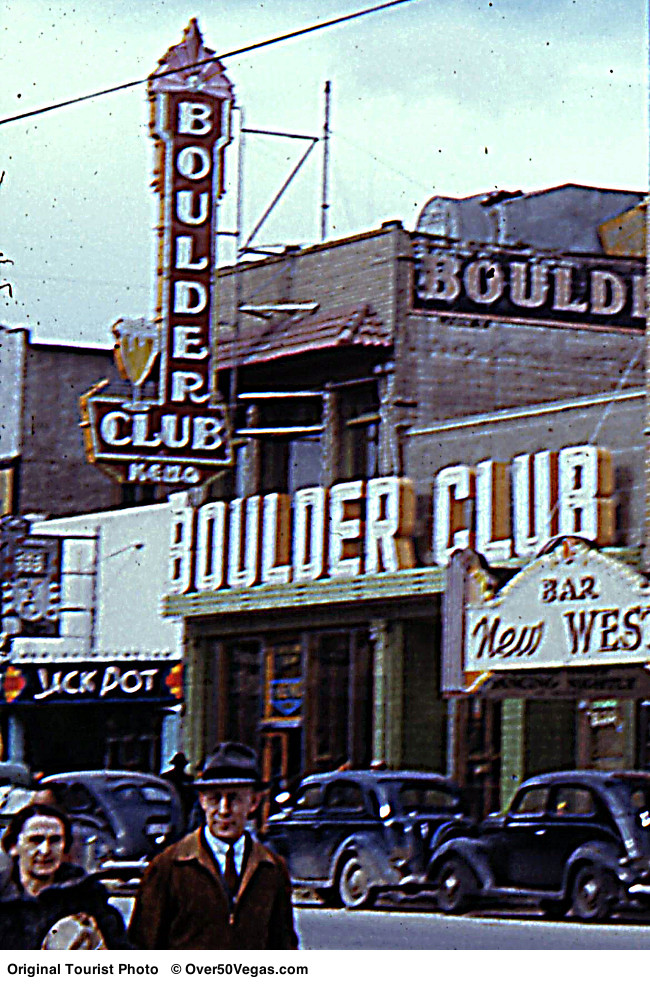
A unique color tourist photo of the Boulder Club with its neon sign.
This photo was dated 1941. The Jackpot Club is on the left and the New Western is on the right in the photo.
Captain History has a great article about Neon in Las Vegas -1928 to 1930
Here is a short excerpt dealing with the Boulder Club. Please visit his site and read the fascinating story of neon in early Las Vegas.
Since the new club was in the middle of the business district, Goumond decided he needed a sign that could be seen at the railroad depot, and by drivers traveling on U.S. 91.
The Boulder Club opened on Saturday night, July 27, 1929, with gaming tables on the west side of the long two-story building; the bar and a few “nickel-in-the-slot-machines” were on the east side.
Goumond called his place,
“Nevada’s Finest Men’s Club.”
His advertisements would not mention gambling, as that was covered in the word “Club.”
Goumond did point to his,
“Soda Fountain, Sandwiches, Candies, Cigars, Cigarettes, and Tobaccos.”
On opening day, the Las Vegas Age promoted the Boulder Club saying the new business was “crowned with its great twelve-foot Neon sign.”
from: Display advertisement, Boulder Club, |
July 27, 1929, Las Vegas Review, page three. |
“Boulder Club Holds Grand Opening T’Day,” |
July 27, 1929, Las Vegas Age, page one. |
The first full gaming license issued for the Boulder Club was on April 1, 1931, according to Fuller's Index Plus. Listed on the original 1931 gaming license were: P. J. Goumond, Clyde Hatch, J.V. Murphy, and Walter Watson. The license holders would change over the years as interests in the club were bought and sold.
The April 1, 1931 date for the license comes after gambling was legalized statewide in Nevada, but the Boulder Club was open for the gaming business two years prior to that.
In the minutes shown below for The Board of City Commissioners on June 18, 1929 the Boulder Club was issued a gaming license for 3 tables for the third quarter of 1929.
(Note: Gambling was outlawed in Nevada in 1910 and would not be legalized in Nevada until March 19, 1931. |
However, poker could be played if the house did not take a percentage.
It's a little unclear to me what exactly the "gaming" license entailed besides renting tables for cardplay.)

0n March 6, 1933 all Keno games in Las Vegas were closed, following action of the city council in canceling all such permits because of moral reasons. The council denied a license for Keno to the Boulder Club and revoked the licenses at The Rainbow Club and the Vegas Club.
The order said:
“It has been called to the attention of this board, by a committee of the Grand Jury, that the playing of Keno as a licensed game in the city of Las Vegas has a demoralizing effect upon the good morals of the city and further that the game constitutes a lottery, and is an unlawful game" |
(Excerpts from the
Nevada State Journal March 7, 1933)
January 1949 Prosper J. Goumond and Lillian W. Witcher were running the race book at the Boulder Club.
The Boulder Club race book had been operated by Connie Hurley up until December 31, 1948, but his permit was revoked by the board.
The race book license was then given to James L. Young, Larry Hezzlewood and Marion Woodworth.
Photograph to the left of the interior of the Boulder Club in about 1953.
One of the original founders of the Boulder Club,
Prosper Jacob (P. J.) Goumond, died November 24, 1954.
He had been a Nevada resident for more than 50 years and he died at the age of 78.
An obituary in the Reno Gazette journal on November 26, 1954 said that he had been born December 10, 1875 in Ohio and came to Las Vegas in 1929 when he and the late A. B. Witcher established the Boulder Club. (The Murphy brothers, Walter Watson and Clyde Hatch and were not mentioned in the obit)
He was survived by his granddaughter Mrs. Michael (Margo Goumond) Hines of Las Vegas.
P. J. Goumond left most of his estate, valued at over $876,000 to his granddaughter Margo Goumond Hines. His will was admitted to probate.
However a year later the will was contested by Madge Egolf, 42, who contended that she was Goumond's “sweetheart” and he had intended to leave the bulk of his estate to her instead of his granddaughter. Miss Egolf worked for the Boulder Club and Goumond until his death.
Goumond had included a codicil in his will that left Madge Egolf the sum of $5,000. At the time of his death Goumond was listed as a 25% owner of the Boulder Club.
(Excerpts from the Reno Gazette Journal May 17th 1955 shown at left)
The case contesting P. J. Goumond's will was finally dismissed on September 11, 1956.
In dismissing the case the judge said contracts such as Miss Egolf claimed to have are “against public policy and and encourage immorality.”
He called the language of the complaint "shocking and bold."
(Excerpts from the Reno Gazette Journal Sept 12, 1956)
P. J. Goumond's house was located at 420 S. 7th Street and has been relocated to Heritage Street, a collection of restored historic buildings that depict daily life from different decades in Las Vegas, Boulder City, Henderson and Goldfield at the Clark County Museum. It was moved in 1984 and opened in 1999.

When the fire broke out, a safe containing $190,000 in cash was transferred under heavy guard from the Boulder Club to the Horseshoe Club for safekeeping.
There was extensive fire, smoke, and water damage. It was the first time the club had been closed since it opened in 1929.
The club was temporarily closed on November 26, 1956 for repairs and an investigation into the source of the fire. Earnest Amante, one of the operators of the Boulder Club, said plans were underway to reopen as soon as possible.
(Excerpts from an article in the Reno Gazette Journal November 26th, 1956)
An article a few days later said,
“carelessness of employees or a possible juvenile prank”
were held out as among the possible causes of the fire. Officials had ruled out spontaneous combustion, faulty electrical wiring, or arson at the time.
Shortly after the legal case concerning Goumond's estate made its way through the courts,
the second floor of the Boulder Club was the site of a devastating fire.
The fire broke out on the night of Nov 25, 1956 in the forward part of the building and climbed up to the second story. Thirty firemen fought the blaze from three sides and it took about an hour to get it under control. One person, elderly custodian Eddie Roach, was trapped inside by the fire but was rescued by the fire department.
There was some damage reported to the interior of the adjoining Apache Hotel, but the Horseshoe Club next door escaped damage.

In August of 1931, gambling is legal statewide when evangelist Minnie “Ma” Kennedy
took to the top of a gaming table in the Boulder Club to preach!
The new operating group would consist of owners J.K. Houssels, Sr.,
Larry Hezzlewood,
Mrs. Michael Hines, (the granddaughter of the late P.J. Goumond),
Connie Hurley,
Jim Young, and Lillian W. Witcher.
When the control board approved the new operators Milton B. “Farmer” Page was also included.
The new operating partnership agreed to place a $200,000 bankroll in the establishment.
Larry Hezzlewood and Farmer Page were in active charge of the club when it reopened about April 12th 1957.
(Excerpts from an article in the Reno Gazette-Journal April 6, 1957)
The Boulder Club was operated under a lease to the Amante Brothers and Associates in 1957 when they informed the owners of the club that they could no longer remain in business. The owners then planned to resume management themselves, but would have to go through regular channels to get the necessary permits.
A close-up of the new sign shows the owners names prominently displayed.
Photo is from the 1958 Helldorado Parade
The closure was based upon an earlier agreement by the owners, that upon the death of one of the partners the club would cease operation.
Milton “Farmer” Page died on September 12, 1960 and his widow decided against continuing the partnership operation.
Ed Levinson, president of the Fremont Hotel and head of a group operating the Horseshoe Club, said the Horseshoe would take over the Boulder Club on January 1, 1961.
A wall separating them would be knocked out and the clubs would be operated as one.
(Excerpts from an article in
the Reno Gazette-Journal October 1, 1960)
The operation of the Boulder Club with the original partners did not last much longer.
It closed on September 30, 1960 after 31 years of continuous operation.

Over50Vegas.com by Over50Vegas.com is licensed under a Creative Commons Attribution-NonCommercial-NoDerivs 3.0 Unported License.
Based on a work at http://over50vegas.com/index.html.
This is a non-commercial, educational, hobby site. Images on this site are from our personal collection and from personal collections of fellow enthusiasts who have shared their scans with us. Other images are noted by source with links to the original. If you feel that any image used here has infringed upon fair use of an image you hold the copyright to, please contact us at the links above and it will be credited or removed at your request.
Sources you might want to visit for more information include:

Search for anything on this site. Click "Advanced" to narrow your search.
